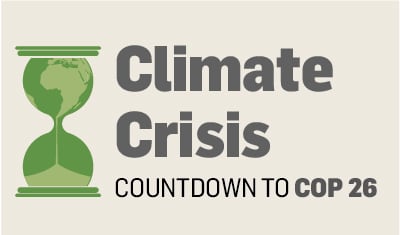A powerful greenhouse gas responsible for 40 per cent of the world's warming over the past decade is spewing into the atmosphere from a site in Glasgow not far from where the Cop26 climate summit is set to begin.

Methane from a gas pipeline near to Ibrox football stadium, detected by researchers from Royal Holloway University of London, is leaking at a rate equivalent to 50 tonnes per year - the same as the emissions of 500 cows - the researchers estimated.
“It was strikingly larger than the other leaks we saw,” said Rebecca Fisher, the academic who found the invisible plume using car-mounted measuring instruments. “It really stood out.”
Methane will be the top priority at Cop26, which starts on October 31st just a mile away from the large leak, as delegates will be asked for the first time to sign up to a pledge to slash emissions.
The commitment, backed by the US and EU, has already gained support from 33 countries that have pledged to cut emissions by 30 per cent over the next decade, although large emitters China, Russia and India have not yet signed up.
Cutting methane emissions was “the fastest strategy we have” to limit global warming to the 1.5 degrees level, according to US climate envoy John Kerry, as set down as the ideal goal under the Paris agreement that aims to keep warming well below 2 degrees.
‘Single most important avenue for progress’
“The methane pledge may be the single most important avenue for progress at Glasgow,” said Paul Bledsoe, a climate adviser under former US president Bill Clinton now at the Progressive Policy Institute think-tank.
Cutting methane would slow near-term temperature rises, he added, which was critical to help avoid climate “tipping points” in natural systems.
Methane is about 80 times more potent than carbon dioxide in terms of pound-for-pound warming potential over a 20-year time period. But because it remains in the atmosphere for only about a decade - while CO2 can remain for a century or more - cutting methane emissions can have a quicker effect on temperatures.
Methane is the major ingredient in natural gas, and fossil fuels account for about 35 per cent of human-caused emissions. Waste and landfills account for about a fifth and agriculture for about 40 per cent.
Washington and Brussels are both preparing new methane regulations - which could come as soon as next week in the US. One measure under discussion in the EU is whether to regulate methane emissions associated with imported gas.
However, the leak near the Cop26 venue shows that methane emissions are often from mundane sources. After driving 350km around Scotland’s biggest city, Fisher found emissions every four kilometres on average, including four classed as large or medium-sized.
“That’s just gas that’s wasted,” she said. “Gas leaks are probably the easiest ones to fix compared with the other anthropogenic sources of methane.”
SGN, the distribution company which operates Glasgow’s pipelines, said it was aware of the Ibrox leak and planned to fix it, but that it could not switch off the gas immediately and maintain customer supply. An extensive pipe replacement programme was under way in the city, it added. – Copyright The Financial Times Limited 2021















